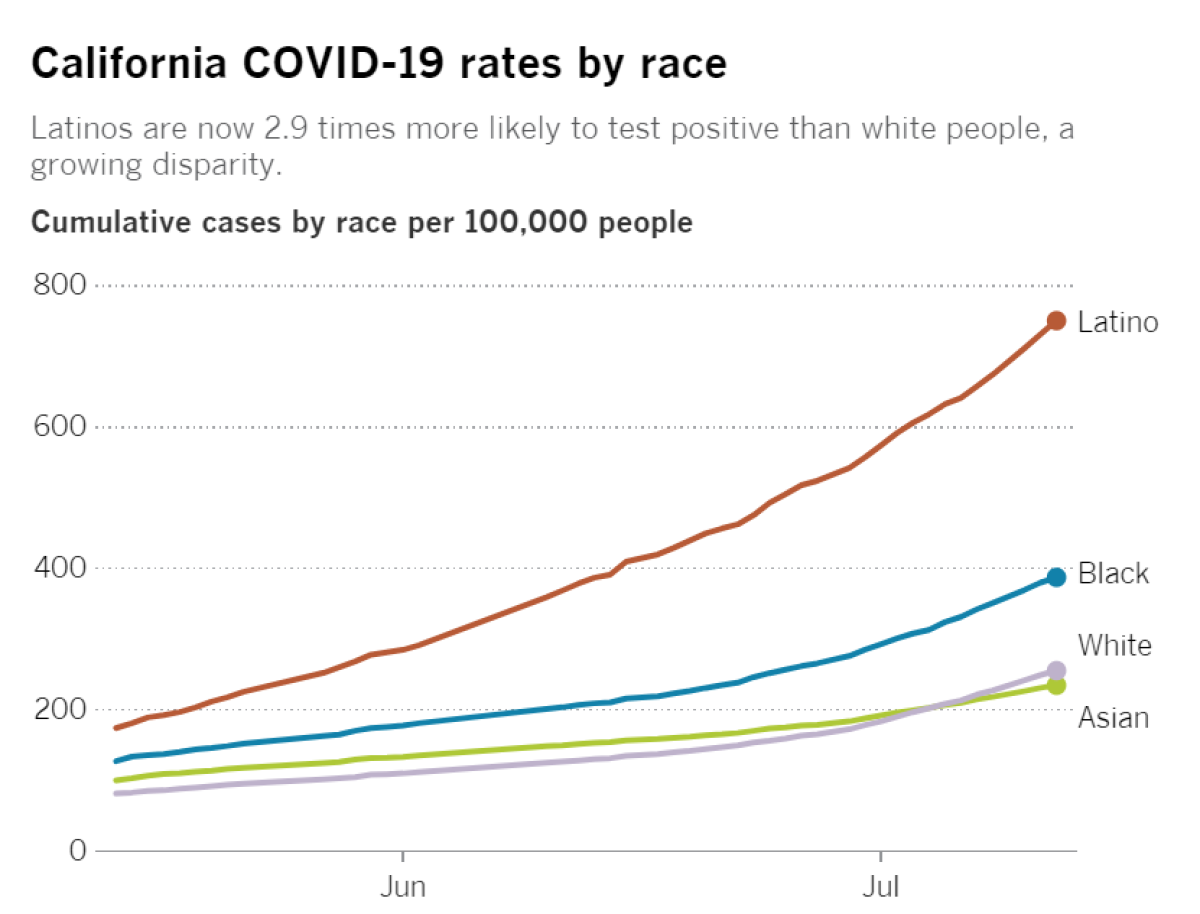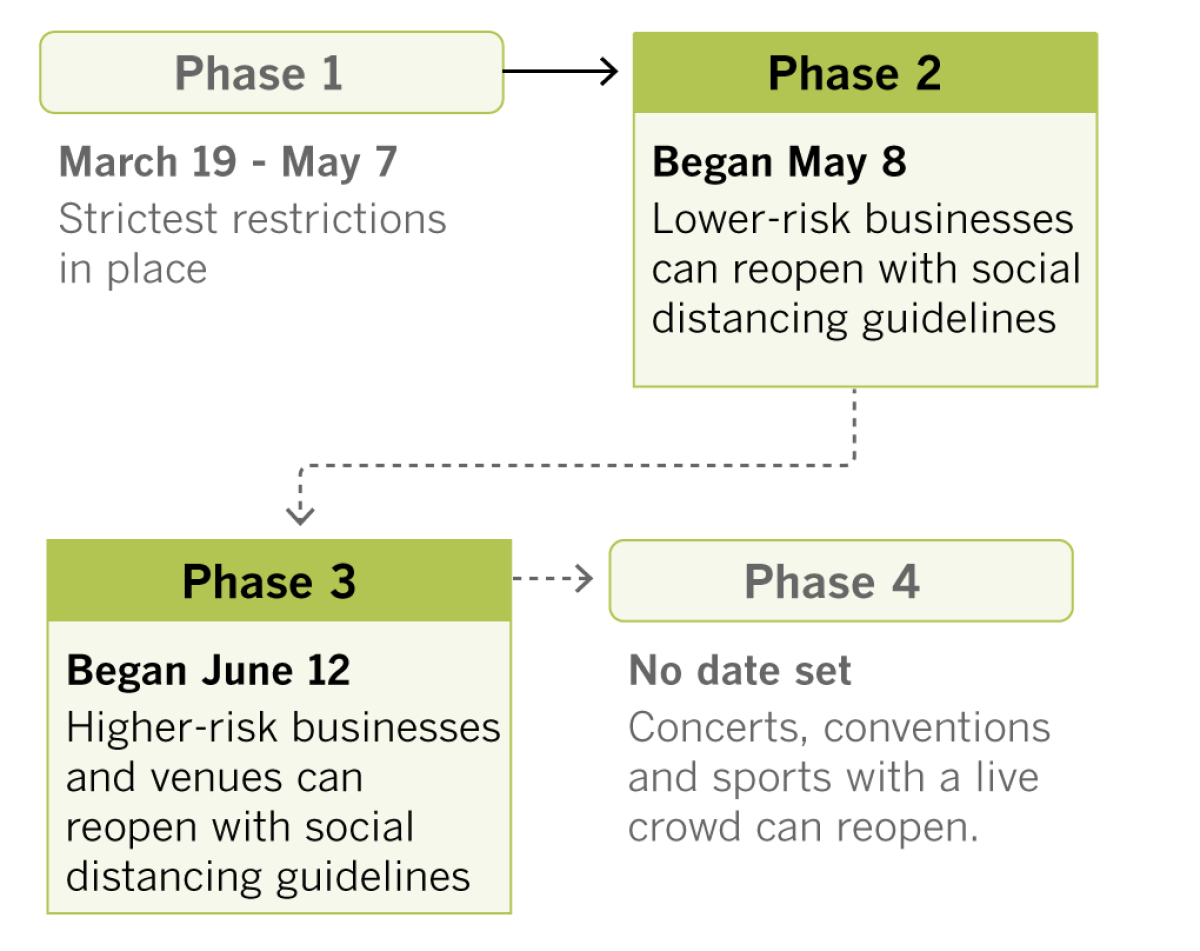Coronavirus Today: San Francisco’s ‘red zone’
- Share via
Good evening. I’m Diya Chacko, and it’s Wednesday, July 15. Here’s what’s happening with the coronavirus in California and beyond.
San Francisco has now joined other California cities in halting its reopening.
The city is in what its health chief, Grant Colfax, calls the “red zone” for rising COVID-19 transmission: Each infected person now spreads the disease to an average of 1.3 other San Francisco residents. That number needs to be one or lower, Colfax said Wednesday. “If we do not do better, we are looking at major problems by late August and September.”
Across California, cases and hospitalizations hit a new high on Tuesday, and another 144 fatalities were reported. In total, more than 7,300 Californians have died from COVID-19. Latinos have been hit especially hard: They make up nearly 39% of the state’s population but 55% of its COVID-19 cases.

The state’s biggest outbreaks have been in Southern California and the Central Valley, where economies are particularly reliant on Latino workers. “My worst fear is infecting my daughters,” said a truck driver from Alhambra, who added that he’s been provided only two masks every three to four weeks. “They don’t care about the drivers, and we’re the ones doing all the dirty work.”
There‘s some positive news on the vaccine front. Results from a Phase 1 clinical trial of a candidate vaccine being developed by Moderna Inc. confirm that it did induce the production of coronavirus antibodies in human test subjects. Additionally, the levels of antibodies were comparable to those in patients who had contracted COVID-19 and recovered.
However, that does not necessarily mean that the vaccine can provide immunity to the disease — just that the results “support continued development,” according to the chief executive of the Bill and Melinda Gates Medical Research Institute. “We must bear in mind the complexity of vaccine development and the work still to be done.”
By the numbers
California cases and deaths as of 4:30 p.m. PDT Wednesday:

Track the latest numbers and how they break down in California with our graphics.

See which counties are reopening with our tracker.
Consider subscribing to the Los Angeles Times
Your support helps us deliver the news that matters most. Become a subscriber.
Across California
The California Department of Education’s guide for schools, updated last month, says the decision to reopen campuses will be made by each of the state’s more than 1,000 school districts. That hasn’t changed, even with cases rising across the state and some districts scheduled to begin a new academic year in less than three weeks.
Even some of Gov. Gavin Newsom’s supporters say the lack of state rules is no longer acceptable, given the growing tension among parents and educators over conflicting orders from local officials. (Orange County is a case in point.) “The burden of making this decision has to rest on his shoulders,” said the president of the California Federation of Teachers.
The superintendent of the Los Angeles Unified School District has said it might be unsafe to open campuses until coronavirus testing is available to all K-12 students and employees on a regular, perhaps weekly, basis. That would mean enough tests for nearly half a million students and 75,000 staff members, which would dwarf the county’s current testing levels and strain an infrastructure already failing to keep up with demand.
L.A. County health director Barbara Ferrer said she had some concerns about that scale of testing and how effective it might prove. “Right now, I would urge us to really focus a lot on the infection control and the distancing protocols that we’ve put in place,” she said.
The 2021 Tournament of Roses Parade has been canceled for the first time in 75 years. Officials initially hoped they’d be able to hold the Rose Parade safely, but after weeks of assessment, it became clear such a feat would be impossible as “the reality of the pandemic set in,” said the tournament’s chief executive. The Rose Bowl football game is still planned for Jan. 1, he said, whether it‘s played in front of socially distanced fans or an empty stadium.
Resources
— For general safety, wash your hands for at least 20 seconds (here’s a super-fun how-to video). Stop touching your face, and keep your phone clean. Practice social distancing, maintaining a six-foot radius of personal space in public. And wear a mask if you leave home. Here’s how to do it right.
— Watch for symptoms including fever, cough, shortness of breath, chills, repeated shaking with chills, muscle pain, headache, sore throat and loss of taste or smell. If you’re worried you might be infected, call your doctor or urgent care clinic before going there.
— Need a COVID-19 test? Here’s how to receive a free test if you’re in L.A. County. And here’s a map of testing sites across California.
— Here’s how to care for someone with COVID-19, from monitoring their symptoms to preventing the virus’ spread.
— If your job has been affected by the pandemic, here’s how to file for unemployment.
— Here are some free resources for restaurant workers and entertainment industry professionals having trouble making ends meet.
— Advice for helping kids navigate pandemic life includes being honest about uncertainties, acknowledging their feelings and sticking to a routine. Here’s guidance from the Centers for Disease Control and Prevention.
— In need of mental health services? Here are resources for coping during the crisis from the CDC and the L.A. County Department of Public Health. L.A. County residents can also call (800) 854-7771 or text “LA” to 741741.
— Thinking about going out? Here’s how you can assess your risk.
Around the nation and the world
Walmart will require all customers to wear masks in its U.S. stores as of July 20. The retailer will place employees, dubbed “health ambassadors,” near entrances to “remind those without a mask of the new requirements,” said the company’s chief operating officer. The policy also applies to the company’s warehouse retailer Sam’s Club and follows similar rules made by Costco, Starbucks and Best Buy.
Olympic leaders’ decision to postpone the 2022 Youth Olympics by four years is raising questions about whether the Tokyo Games, currently scheduled for next summer, might also be pushed back. With the virus still surging, recent polls have shown the Japanese people remain skeptical about welcoming thousands of athletes, officials and fans to their country. The International Olympic Committee says it’s still working with the World Health Organization on plans that allow the Summer Games to take place in 2021.
Lockdown orders are being reimposed in parts of India as its caseload approaches 1 million and governments try to shield the health system from being overwhelmed. The nationwide restriction was eased in June to help mitigate more than $133 billion in predicted losses; authorities are now increasingly trying to localize their lockdowns to shield the economy from further damage.
Your questions answered
Today’s question comes from readers who want to know: How does contact tracing work? Here’s a quick breakdown of the process.
Contact tracing is meant to stop the spread of disease by finding people who may have been exposed and prevent them from spreading it to others. The process is simple to understand but not easy to implement in this pandemic.
After a person tests positive for the coronavirus, a contact tracer would get in touch with them and attempt to determine where they have been recently and who they were around. The main focus is on close contacts, or people who were within six feet of the infected person for at least 10 minutes or so.
Next, the tracer would track down those close contacts and ask them to self-isolate and get tested if needed. For those showing symptoms, the tracing process would be repeated.
The whole effort gets more and more complicated if people have spent lots of time around family and friends, and inside bars, restaurants and other public indoor spaces. There’s also added pressure to act quickly — the longer a person goes without being alerted, the greater the risk they’ll spread the disease if they do have it.
One added benefit of contact tracing is that it can provide data about the relative safety of different activities and environments. For instance, contact tracing in Sacramento found that the biggest sources of recent spread there were graduation parties and funeral gatherings.
Got a question? Our reporters covering the coronavirus outbreak want to hear from you. Email us your questions, and we’ll do our best to answer them. You can find more answers in our Frequently Asked Questions roundup and on our coronavirus roundup page.
For the most up-to-date coronavirus coverage from The Times, visit our homepage and our Health section, listen to our “Coronavirus in California” podcast and follow us on Twitter and on Instagram.




